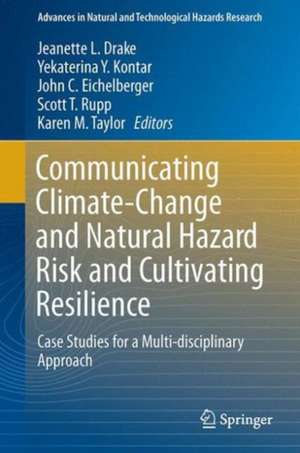Communicating Climate-Change and Natural Hazard Risk and Cultivating Resilience: Case Studies for a Multi-disciplinary Approach: Advances in Natural and Technological Hazards Research, cartea 45
Editat de Jeanette L. Drake, Yekaterina Y. Kontar, John C. Eichelberger, T. Scott Rupp, Karen M. Tayloren Limba Engleză Hardback – 16 noi 2015
This book is dedicated to all those who have directly or indirectly suffered the effects of climate change end extreme events with the hope that the advance of knowledge, implementation of sound science and appropriate policies and use of effective communication will help in reducing their vulnerability while also improving resilience in the face of often devastating natural and technological disasters.
| Toate formatele și edițiile | Preț | Express |
|---|---|---|
| Paperback (1) | 642.68 lei 6-8 săpt. | |
| Springer International Publishing – 23 aug 2016 | 642.68 lei 6-8 săpt. | |
| Hardback (1) | 582.27 lei 38-44 zile | |
| Springer International Publishing – 16 noi 2015 | 582.27 lei 38-44 zile |
Din seria Advances in Natural and Technological Hazards Research
- 18%
 Preț: 977.97 lei
Preț: 977.97 lei - 18%
 Preț: 921.15 lei
Preț: 921.15 lei - 18%
 Preț: 1406.35 lei
Preț: 1406.35 lei - 18%
 Preț: 788.72 lei
Preț: 788.72 lei - 15%
 Preț: 643.84 lei
Preț: 643.84 lei - 18%
 Preț: 955.56 lei
Preț: 955.56 lei - 18%
 Preț: 954.31 lei
Preț: 954.31 lei - 18%
 Preț: 958.56 lei
Preț: 958.56 lei - 18%
 Preț: 937.56 lei
Preț: 937.56 lei - 18%
 Preț: 952.72 lei
Preț: 952.72 lei -
 Preț: 382.18 lei
Preț: 382.18 lei - 15%
 Preț: 647.92 lei
Preț: 647.92 lei - 18%
 Preț: 948.47 lei
Preț: 948.47 lei - 15%
 Preț: 640.06 lei
Preț: 640.06 lei -
 Preț: 407.01 lei
Preț: 407.01 lei - 15%
![Submarine Mass Movements and Their Consequences [With CDROM]](https://i4.books-express.ro/bs/9781402012440/submarine-mass-movements-and-their-consequences-with-cdrom.jpg) Preț: 604.37 lei
Preț: 604.37 lei - 15%
 Preț: 643.48 lei
Preț: 643.48 lei - 15%
 Preț: 648.05 lei
Preț: 648.05 lei - 18%
 Preț: 1236.99 lei
Preț: 1236.99 lei - 18%
 Preț: 947.35 lei
Preț: 947.35 lei - 18%
 Preț: 947.35 lei
Preț: 947.35 lei - 18%
 Preț: 966.15 lei
Preț: 966.15 lei - 15%
 Preț: 642.51 lei
Preț: 642.51 lei - 18%
 Preț: 951.29 lei
Preț: 951.29 lei - 18%
 Preț: 1255.16 lei
Preț: 1255.16 lei - 15%
 Preț: 642.51 lei
Preț: 642.51 lei - 15%
 Preț: 646.43 lei
Preț: 646.43 lei - 15%
 Preț: 635.96 lei
Preț: 635.96 lei - 18%
 Preț: 1244.08 lei
Preț: 1244.08 lei
Preț: 582.27 lei
Preț vechi: 727.83 lei
-20% Nou
Puncte Express: 873
Preț estimativ în valută:
111.43€ • 120.100$ • 93.60£
111.43€ • 120.100$ • 93.60£
Carte tipărită la comandă
Livrare economică 18-24 aprilie
Preluare comenzi: 021 569.72.76
Specificații
ISBN-13: 9783319201603
ISBN-10: 3319201603
Pagini: 311
Ilustrații: XXXII, 311 p.
Dimensiuni: 155 x 235 x 22 mm
Greutate: 0.77 kg
Ediția:1st ed. 2016
Editura: Springer International Publishing
Colecția Springer
Seria Advances in Natural and Technological Hazards Research
Locul publicării:Cham, Switzerland
ISBN-10: 3319201603
Pagini: 311
Ilustrații: XXXII, 311 p.
Dimensiuni: 155 x 235 x 22 mm
Greutate: 0.77 kg
Ediția:1st ed. 2016
Editura: Springer International Publishing
Colecția Springer
Seria Advances in Natural and Technological Hazards Research
Locul publicării:Cham, Switzerland
Public țintă
ResearchCuprins
Chapter 1. Introduction: An Overview of Crisis Communication.- Part I. The Role of Communication in Fostering Resilience or Fomenting Resistance.- Chapter 2. Revisiting Crisis Communication and Integrating Social Media.- Chapter 3. Polluted Discourse: Communication and Myths in a Climate of Denial.- Chapter 4. Public Perceptions of Global Warming: Understanding Survey Differences.- Chapter 5. Building Interfaces that Work: A Multi-Stakeholder Approach to Air Pollution and Climate Change Mitigation.- Part II. Before Disaster: Prediction, Preparation and Crisis Communication.- Chapter 6. Fostering Resilience in the Face of an Uncertain Future: Using Scenarios Planning to Communicate Climate Change Risks and Collaboratively Develop Adaptation Strategies.- Chapter 7. Barriers to Using Climate Information: Challenges in Communicating Probabilistic Forecasts to Decision Makers.- Chapter 8. Modeling Climate-Sensitive Disease Risk: A Decision Support Tool for Public Health Services.- Chapter 9. Shallow Landslide Hazard Mapping for Davao Oriental, Philippines Using a Deterministic GIS Model.- Part III. Mitigating Circumstances: Communicating Through Change, Uncertainty, Disaster and Recovery.- Chapter 10. Comparative Analysis of Virtual Relief Networks and Communication Channels During Disaster Recovery After a Major Flood in Galena, Alaska, Spring 2013.- Chapter 11. Development of the Stakeholders’ Engagement Plan as a Mining Social Responsibility Practice.- Chapter 12. Controlling Environmental Crisis Messages in Uncontrollable Media Environments: The 2011 Case of Blue-Green Algae on Grand Lake O’ the Cherokees, OK.- Chapter 13. Characteristics of Extreme Monsoon Floods and Local Land Use in the Lower Mekong Basin, Cambodia.- Chapter 14. The Value of Earth Observations: Methods and Findings on the Value of Landsat Imagery.- Part IV. Learning Forward: Advancing Climate Change Science Among Diverse Audiences.- Chapter 15. Carbon Offsets in California:Science in the Policy Development Process.- Chapter 16. Fostering Educator Resilience: Engaging the Educational Community to Address the Natural Hazards of Climate Change.- Chapter 17. Communicating Uncertainty: A Challenge for Science Communication.- Chapter 18. Science Diplomacy in the Geosciences.- Chapter 19. Stormy Seas, Rising Risks: Assessing Undisclosed Risk from Sea Level Risk and Storm Surge at Coastal U.S. Oil Refineries.
Textul de pe ultima copertă
This edited volume emphasizes risk and crisis communication principles and practices within the up-to the minute context of new technologies, a new focus on resiliency, and global environmental change. It includes contributions from experts from around the globe whose research, advocacy, teaching, work, or service in the natural or social sciences deals with risk communication and/or management surrounding natural and technological disasters, with a particular focus on climate change-related phenomena. Resilience and good communication are intimately linked and with climate change precipitating more numerous and onerous weather-related catastrophes, a conversation on resilience is timely and necessary. The goal is robust communities that are able to withstand the shock of disaster. Communicating well under ordinary circumstances is challenging; communicating during a crisis is extraordinarily difficult.
This book is dedicated to all those who have directly or indirectly suffered the effects of climate change end extreme events with the hope that the advance of knowledge, implementation of sound science and appropriate policies, and use of effective communication will help in reducing their vulnerability while also improving resilience in the face of often devastating natural and technological disasters.
This book is dedicated to all those who have directly or indirectly suffered the effects of climate change end extreme events with the hope that the advance of knowledge, implementation of sound science and appropriate policies, and use of effective communication will help in reducing their vulnerability while also improving resilience in the face of often devastating natural and technological disasters.
Caracteristici
Manual of risk and resilience communication for scientists, policymakers and professionals Up-to-the-minute context of communicating about natural disasters By geoscientists for geoscientists working with social scientists and communication principles Underpinned by key communication theories and interspersed with pragmatic solutions Crosses traditional boundaries: international, interdisciplinary, theoretical/applied











